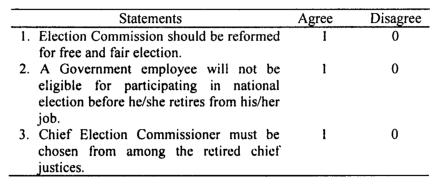The relationship among Concept, Indicator, and Construct in Research is a hierarchy;
- At the top level, you have the abstract concept.
- This concept is made measurable through indicators.
- Multiple related concepts and their indicators can be combined to form a construct.
Concept
The concept is a name given to a category that organizes observations and ideas by possessing common features. As Bulmer succinctly puts it, concepts are categories for organizing ideas and observations.
If a concept is to be employed in quantitative research, it must be measured. Once they are measured, concepts can be in the form of independent or dependent variables.
In other words, concepts may explain (explanatory variable) a certain aspect of the social world, or they may stand for things we want to explain (dependent variable).
Examples of concepts are social mobility, religious orthodoxy, social class, culture, lifestyle, academic achievement, and the like.
Intelligence,” “motivation,” and “happiness” are all concepts. They represent ideas that are understood and recognized by individuals but are not directly observable.
What is a concept in research?
A concept is a name given to a category that organizes observations and ideas by possessing common features. It can be employed in quantitative research and may serve as either an independent or dependent variable. Examples include social mobility, religious orthodoxy, and academic achievement.
Indicator
An indicator is a measure that is employed to refer to a concept when no direct measure is available. We use indicators to tap concepts that are less directly quantifiable.
To understand an indicator, it is worth distinguishing between a measure and an indicator. An indicator can refer to things relatively unambiguously counted, such as income, age, number of children, etc.
Measures, in other words, are quantities. If we are interested in some of the causes of variation in income, the latter can be quantified in a reasonably direct way.
We use indicators to tap concepts that are less directly quantifiable. If we are interested in the causes of variation in job satisfaction, we will need indicators that will stand for the concept.
These indicators allow job satisfaction to be measured, and we can treat the resulting quantitative information as if it were a measure.
An indicator, then, is something that is devised or already exists and that is employed as though it were a measure of a concept.
It is viewed as an indirect measure of a concept, like job satisfaction. An IQ is a further example in that it is a battery of indicators of the concept of intelligence.
For example, for the concept of “intelligence,” an indicator might be a score on an IQ test. For “happiness,” it could be the number of times a person smiles in a day or their responses to a happiness questionnaire.
How does an indicator differ from a measure in research?
An indicator is used to refer to a concept when no direct measure is available. It is viewed as an indirect measure of a concept. On the other hand, a measure refers to things that can be directly quantified, such as income or age.
Construct
A construct is an abstraction or concept deliberately invented or constructed by a researcher for a scientific purpose.
In a scientific theory, particularly within psychology, a hypothetical construct is an explanatory variable that is not directly observable.
For example, the concepts of intelligence and motivation are used to explain phenomena in psychology, but neither is directly observable.
A hypothetical construct differs from an intervening variable in that construct has properties and implications which have not been demonstrated in empirical research. These serve as a guide for further research. On the other hand, an intervening variable is a summary of observed empirical findings.
Cronbach and Meehl (1955) define a hypothetical construct as a concept for which there is not a single observable referent, which cannot be directly observed, and for which there exist multiple referents, but none are all-inclusive.
For example, according to Cronbach and Meehl, a fish is not a hypothetical construct because, despite variation in species and varieties of fish, there is an agreed-upon definition for a fish with specific characteristics that distinguish a fish from a bird.
Furthermore, fish can be directly observed.
On the other hand, a hypothetical construct has no single referent; hypothetical constructs consist of groups of functionally related behaviors, attitudes, processes, and experiences.
Instead of seeing intelligence, love, or fear, we see indicators or manifestations of what we have agreed to call intelligence, love, or fear.
For instance, “emotional intelligence” is a construct that encompasses various concepts like empathy, self-awareness, and interpersonal skills, each of which can have its own set of indicators.
Other examples of constructs:
- In Biology: Genes, evolution, illness, taxonomy, immunity
- In Physics/Astrophysics: Black holes, the Big Bang, Dark Matter, String Theory, molecular physics or atoms, gravity, the center of mass
- In Psychology: Intelligence or knowledge, emotions, personality, moods.
What is a construct in the context of scientific research?
A construct is an abstraction or concept deliberately invented or constructed by a researcher for a scientific purpose. It is an explanatory variable that is not directly observable. Constructs have properties and implications that guide further research.
How is a hypothetical construct different from an intervening variable?
A hypothetical construct is a concept for which there is no observable referent and multiple referents. An intervening variable, however, is a summary of observed empirical findings.

